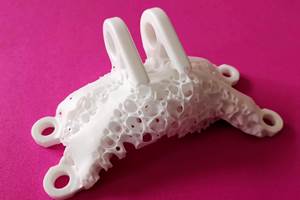Renishaw Tempus Technology Reduces Metal Additive Manufacturing Build Times
A new scanning algorithm for Renishaw’s RenAM 500 series of metal additive manufacturing systems enables the laser to fire while the recoater is moving, which over the build cycle can reduce total build time by up to 50% with no reduction in part quality.
The Tempus technology reduces the dwell time per layer, thereby shortening cycle times. Photo Credit: Renishaw
Renishaw’s Tempus technology enables users of its additive manufacturing (AM) systems to achieve significantly higher productivity, with no reduction in part quality. The company says the time and cost savings achieved through Tempus technology will further the use of AM as a volume production method and help drive wider adoption.
The Tempus technology incorporates a new scanning algorithm for Renishaw’s RenAM 500 series of metal AM systems, which enables the laser to fire while the recoater is moving, thereby saving up to nine seconds per build layer. Over the cycle time of the build, the time savings can cut the build time by up to 50%. Crucially, there is no reduction in part quality.
With Tempus technology, as the recoater spreads a layer of powder, the lasers “follow” the recoater, melting the powder being spread before the recoater completes its stroke. When the recoater goes back to the doser to collect more powder, the lasers “jump over” the recoater and continue melting the current layer, mitigating wiper time. As the recoater begins spreading the next layer of powder, the lasers finish the previous layer, and simultaneously start processing the new layer. Tempus technology reduces the dwell time per layer, thereby shortening cycle times.
The technology works using advanced scanning algorithms that sequence the layer data in a way that maximizes productivity while maintaining part quality. The optimization is well suited for some part geometries more than others, but all geometries can see some productivity benefits. Those parts with thin, vertical features, for example, are likely to experience higher productivity savings.
“Reducing cost per part is critical to the wider adoption of AM technology,” says Louise Callanan, director of Additive Manufacturing at Renishaw. “The dominant contributing factor to part cost for most components today is the time spent building the part on the machine itself. Reducing the amount of machine time per part, therefore results in more cost-effective production.”
The company says that is why Tempus technology is such a big leap forward. “Usually, the laser would turn off while the recoater is moving. Firing the laser while the recoater is moving minimizes the laser off-time per build,” Callanan says. “The time and cost saving Tempus brings will open AM up to mass production applications where the technology would previously have been unviable.”
Tempus technology is a standard fitment with new RenAM Ultra metal AM systems, which are available with quad- or single-laser configuration. Existing RenAM 500 series customers can access Tempus as a paid-for upgrade. Renishaw data shows that retrofitting Tempus technology to an existing system is the equivalent of adding an extra laser, and enables existing customers to make the most of their machine investment.
For uses in consumer electronics and computing, Renishaw has entered into an exclusive partnership agreement with metal component expert Alloyed, which has been using Tempus technology since 2021.
Renishaw offers a suite of additive manufacturing technologies to help customers develop a high quality, productive end-to-end solution, and has launched software, hardware and processes that enhance the additive manufacturing process chain. Recent launches include Optical System Verification (OSV), a three-stage in-house laser testing and calibration process that enables users to quickly confirm machine performance.
- Read about the Renishaw partnership with CCAT to accelerate technology adoption. Renishaw provided industrial metrology and additive manufacturing equipment to the Connecticut Center for Advanced Technology Inc. (CCAT), as well as sales and applications liaisons for product demonstrations, webinars, training and support.
- Learn how Renishaw metal additive manufacturing enables Domin to create CO2-reducing valve. By using Renishaw’s RenAM 500Q AM system, Domin has created a servo valve that saves one ton of CO2 per year compared to competing products.
Related Content
Implicit Modeling for Additive Manufacturing
Some software tools now use this modeling strategy as opposed to explicit methods of representing geometry. Here’s how it works, and why it matters for additive manufacturing.
Read MoreThe Top 10 Additive Manufacturing Stories of 2024
Defense, space exploration, thermal management — these are some of the topics that captured the Additive Manufacturing audience’s interest in 2024. But there’s also an overarching theme: Don't wait for additive manufacturing to be perfect. Instead, leverage the applications perfect for AM.
Read MoreRobot Vs. Gantry for Large-Format Additive Manufacturing (Includes Video)
Additive Engineering Solutions, specialist at 3D printing very large parts and tools on gantry machines, now also uses a robot for large-format AM. Here is how the robot compares.
Read MoreSpherene Creates Metamaterial with Geometry Derived from Spheres
An algorithm developed by Spherene Inc. generates Adaptive Density Minimal Surfaces (ADMS) as a self-supporting infill strategy that can be used to reduce mass and manage material properties in 3D printed parts.
Read MoreRead Next
Bike Manufacturer Uses Additive Manufacturing to Create Lighter, More Complex, Customized Parts
Titanium bike frame manufacturer Hanglun Technology mixes precision casting with 3D printing to create bikes that offer increased speed and reduced turbulence during long-distance rides, offering a smoother, faster and more efficient cycling experience.
Read More3D Printed Polymer EOAT Increases Safety of Cobots
Contract manufacturer Anubis 3D applies polymer 3D printing processes to manufacture cobot tooling that is lightweight, smooth and safer for human interaction.
Read MoreCrushable Lattices: The Lightweight Structures That Will Protect an Interplanetary Payload
NASA uses laser powder bed fusion plus chemical etching to create the lattice forms engineered to keep Mars rocks safe during a crash landing on Earth.
Read More





















